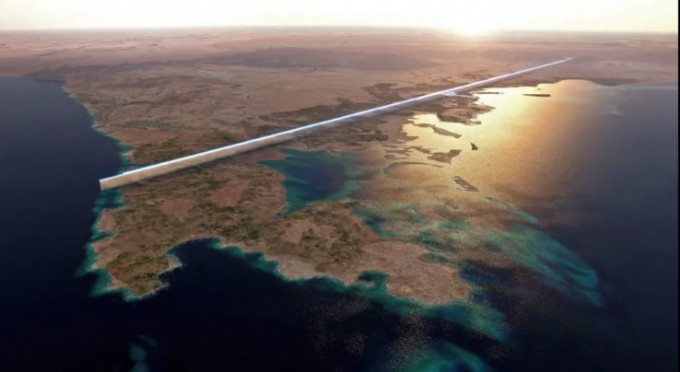Fabulous
How Saudi Arabia’s vanity project is costing Kingdom trillions
Saudi Arabia's NEOM: A Billion-Dollar Vanity Project Plagued by Blunders and Missing Workers.

Saudi Arabia’s ambitious NEOM megacity, touted as a futuristic marvel set to transform the Kingdom’s economy, has become mired in controversy and logistical failures, raising questions about its feasibility and long-term viability. Despite initial excitement, the multi-trillion-dollar project now faces intense scrutiny due to its unrealistic goals, delayed timelines, and alleged human rights abuses, according to experts.
NEOM, a cornerstone of Crown Prince Mohammed bin Salman’s Vision 2030, was designed to reduce Saudi Arabia’s reliance on oil and propel the country into the future as a global innovation powerhouse. With extravagant projects like “The Line” – a linear city envisioned to house millions – and plans for a fake moon and the world’s tallest skyscrapers, the megacity was intended to symbolize the Kingdom’s bold aspirations. However, experts now warn that NEOM may turn into a white elephant, draining the Kingdom’s resources and failing to deliver on its grand promises.
The Lofty Vision of NEOM
NEOM, first announced in 2017, was heralded as one of the most ambitious urban developments in history. Encompassing over 10,000 square miles of desert and mountains near the Red Sea, the project aims to integrate cutting-edge technologies, renewable energy, and futuristic infrastructure to create an unparalleled city of the future.
The flagship project within NEOM, The Line, was particularly ambitious. Originally intended to span 106 miles, the linear city was designed to house 1.5 million residents by 2030 in a mirrored structure with a footprint that stretches across Saudi Arabia’s desert landscape. The city promised to be a “civilizational revolution,” with no cars, roads, or pollution, powered entirely by renewable energy. The futuristic vision generated global headlines and attracted interest from investors eager to capitalize on the Kingdom’s efforts to modernize.
However, this bold vision has faced significant setbacks as costs balloon, timelines are missed, and controversies mount.
Unrealistic Goals and Soaring Costs
Dr. Frederic Schneider, an independent consultant specializing in post-oil economic transitions in the Gulf region, spoke to The Sun about the unrealistic nature of Vision 2030 and NEOM from the outset. He noted that the Kingdom’s grand plans have been viewed by many as overly ambitious and nearly impossible to achieve.
"When Vision 2030 was first announced, there was a lot of talk about how it was hugely ambitious," said Dr. Schneider. "Many people from the start said, 'okay, this is not only ambitious, that’s almost impossible.'"

One of the main challenges NEOM faces is its overwhelming cost. Dr. Schneider highlighted that The Line alone, initially budgeted at £500 billion, is now estimated to cost up to £2 trillion. This staggering price tag makes NEOM one of the most expensive development projects in history, placing immense financial pressure on Saudi Arabia.
Despite the Kingdom’s vast oil wealth, the project’s long-term sustainability has come into question. Foreign investors have been slow to commit to the project, deterred by the high risks and uncertain returns. As global economic trends shift and the viability of such large-scale developments diminishes, NEOM’s financial future appears increasingly precarious.
Scaling Back: The End of The Line?
Recent reports indicate that Saudi Arabia is already scaling back its ambitions for NEOM. The Line, which was once slated to accommodate 1.5 million residents by 2030, is now expected to house only 300,000 people and stretch a mere 1.6 miles. This reduction represents just 1% of its original dimensions, a stark contrast to the grand vision presented to the world.
Latest News
Saudi Arabia's NEOM: A Billion-Dollar Vanity Project Plagued by Blunders and Missing Workers.

Saudi Arabia’s ambitious NEOM megacity, touted as a futuristic marvel set to transform the Kingdom’s economy, has become mired in controversy and logistical failures, raising questions about its feasibility and long-term viability. Despite initial excitement, the multi-trillion-dollar project now faces intense scrutiny due to its unrealistic goals, delayed timelines, and alleged human rights abuses, according to experts.
NEOM, a cornerstone of Crown Prince Mohammed bin Salman’s Vision 2030, was designed to reduce Saudi Arabia’s reliance on oil and propel the country into the future as a global innovation powerhouse. With extravagant projects like “The Line” – a linear city envisioned to house millions – and plans for a fake moon and the world’s tallest skyscrapers, the megacity was intended to symbolize the Kingdom’s bold aspirations. However, experts now warn that NEOM may turn into a white elephant, draining the Kingdom’s resources and failing to deliver on its grand promises.
The Lofty Vision of NEOM
NEOM, first announced in 2017, was heralded as one of the most ambitious urban developments in history. Encompassing over 10,000 square miles of desert and mountains near the Red Sea, the project aims to integrate cutting-edge technologies, renewable energy, and futuristic infrastructure to create an unparalleled city of the future.
The flagship project within NEOM, The Line, was particularly ambitious. Originally intended to span 106 miles, the linear city was designed to house 1.5 million residents by 2030 in a mirrored structure with a footprint that stretches across Saudi Arabia’s desert landscape. The city promised to be a “civilizational revolution,” with no cars, roads, or pollution, powered entirely by renewable energy. The futuristic vision generated global headlines and attracted interest from investors eager to capitalize on the Kingdom’s efforts to modernize.
However, this bold vision has faced significant setbacks as costs balloon, timelines are missed, and controversies mount.
Unrealistic Goals and Soaring Costs
Dr. Frederic Schneider, an independent consultant specializing in post-oil economic transitions in the Gulf region, spoke to The Sun about the unrealistic nature of Vision 2030 and NEOM from the outset. He noted that the Kingdom’s grand plans have been viewed by many as overly ambitious and nearly impossible to achieve.
"When Vision 2030 was first announced, there was a lot of talk about how it was hugely ambitious," said Dr. Schneider. "Many people from the start said, 'okay, this is not only ambitious, that’s almost impossible.'"

One of the main challenges NEOM faces is its overwhelming cost. Dr. Schneider highlighted that The Line alone, initially budgeted at £500 billion, is now estimated to cost up to £2 trillion. This staggering price tag makes NEOM one of the most expensive development projects in history, placing immense financial pressure on Saudi Arabia.
Despite the Kingdom’s vast oil wealth, the project’s long-term sustainability has come into question. Foreign investors have been slow to commit to the project, deterred by the high risks and uncertain returns. As global economic trends shift and the viability of such large-scale developments diminishes, NEOM’s financial future appears increasingly precarious.
Scaling Back: The End of The Line?
Recent reports indicate that Saudi Arabia is already scaling back its ambitions for NEOM. The Line, which was once slated to accommodate 1.5 million residents by 2030, is now expected to house only 300,000 people and stretch a mere 1.6 miles. This reduction represents just 1% of its original dimensions, a stark contrast to the grand vision presented to the world.

Jennifer Lopez looks ageless in a towel in no-makeup video

Amanda Holden spanks her derriere and thanks Spanx

Amanda Holden shows off more than bargained as she dances around in her outfit of the day

Meet Harley Cameron, the stunning model who went from a BKFC ring girl to become a pro wrestler and found love

GreenGirlBella, Rocks Emirates Stadium in Painted Home Kit

Amanda Holden calls herself a 'good girl' in white dress with 'cheeky' split

Mum slammed by parents after flashing thong in school run outfit

Lottie Moss makes jaws dropp as she shows off her flawless body

Amanda Holden wears nothing beneath plunging white dress












Comments
Written news comments are in no way https://www.showbizglow.com it does not reflect the opinions and thoughts of. Comments are binding on the person who wrote them.